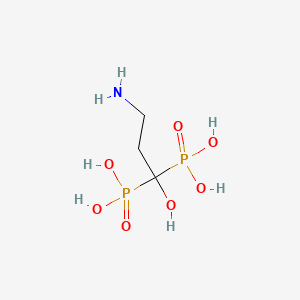Drug Information
Drug (ID: DG00789) and It's Reported Resistant Information
| Name |
Pamidronate
|
||||
|---|---|---|---|---|---|
| Synonyms |
PAMIDRONIC ACID; pamidronate; 40391-99-9; Aredia; Amidronate; Aminomux; (3-amino-1-hydroxy-1-phosphonopropyl)phosphonic acid; Acide pamidronique [INN-French]; Acido pamidronico [INN-Spanish]; Acidum pamidronicum [INN-Latin]; PAMIDRONATE DISODIUM; (3-amino-1-hydroxypropane-1,1-diyl)bis(phosphonic acid); Disodium pamidronate; UNII-OYY3447OMC; (3-Amino-1-hydroxypropylidene)diphosphonic acid; CHEMBL834; OYY3447OMC; Phosphonic acid, (3-amino-1-hydroxypropylidene)bis-; (3-AMINO-1-HYDROXY-1-PHOSPHONO-PROPYL)PHOSPHONIC ACID; 3-amino-1-hydroxypropane-1,1-diphosphonic acid; CGP-23339AE; NCGC00159433-02; DSSTox_CID_3414; Acido pamidronico; Acide pamidronique; Acidum pamidronicum; DSSTox_RID_77017; DSSTox_GSID_23414; 1159812-33-5; (3-Amino-1-hydroxypropane-1,1-diyl)diphosphonic acid; Pamidronic acid [INN:BAN]; Ribodroat; 57248-88-1; Bisphosphonate 6; Ribodroat (TN); CAS-40391-99-9; (3-Amino-1-hydroxypropylidene)bisphosphonic acid; C3H11NO7P2; Pamidronic acid (INN); EINECS 254-905-2; starbld0044121; ChemDiv1_025240; 3-Amino-1-hydroxypropylidene-1,1-diphosphonate; SCHEMBL18361; BIDD:GT0538; CHEBI:7903; GTPL7259; JMC515594 Compound 62; DTXSID4023414; BDBM12581; HMS658L06; HMS2090C13; HMS3749A11; BCP17709; CCG-2075; HY-B0012; ZINC3812862; Tox21_111664; 2631AH; HSCI1_000312; MFCD00168777; s2063; STL510914; AKOS003599275; Tox21_111664_1; CS-7787; DB00282; MCULE-4373491291; NCGC00159433-03; NCGC00165862-02; DB-049579; FT-0630610; C07395; C75045; D07281; 391P999; A825084; Propane-1-hydroxy-3-amino-1,1-diphosphonic acid; Q627499; SR-01000514873; 3-amino-1-hydroxypropane-1,1-diyldiphosphonic acid; SR-01000514873-1; (3-Amino-1-hydroxy-1-phosphono-propyl)-phosphonic acid; Phosphonic acid, P,P'-(3-amino-1-hydroxypropylidene)bis-
Click to Show/Hide
|
||||
| Indication |
In total 1 Indication(s)
|
||||
| Structure |

|
||||
| Drug Resistance Disease(s) |
Disease(s) with Clinically Reported Resistance for This Drug
(1 diseases)
[1]
|
||||
| Target | Geranyltranstransferase (FDPS) | FPPS_HUMAN | [1] | ||
| Click to Show/Hide the Molecular Information and External Link(s) of This Drug | |||||
| Formula |
C3H11NO7P2
|
||||
| IsoSMILES |
C(CN)C(O)(P(=O)(O)O)P(=O)(O)O
|
||||
| InChI |
1S/C3H11NO7P2/c4-2-1-3(5,12(6,7)8)13(9,10)11/h5H,1-2,4H2,(H2,6,7,8)(H2,9,10,11)
|
||||
| InChIKey |
WRUUGTRCQOWXEG-UHFFFAOYSA-N
|
||||
| PubChem CID | |||||
| ChEBI ID | |||||
| TTD Drug ID | |||||
Type(s) of Resistant Mechanism of This Drug
Drug Resistance Data Categorized by Their Corresponding Diseases
ICD-02: Benign/in-situ/malignant neoplasm
| Drug Resistance Data Categorized by Their Corresponding Mechanisms | ||||
|
|
||||
| Key Molecule: GTPase Hras (HRAS) | [1] | |||
| Molecule Alteration | Expression | Down-regulation |
||
| Resistant Disease | Breast cancer [ICD-11: 2C60.3] | |||
| Experimental Note | Identified from the Human Clinical Data | |||
| In Vitro Model | U266 cells | Bone marrow | Homo sapiens (Human) | CVCL_0566 |
| ZR75-1 cells | Breast | Homo sapiens (Human) | CVCL_0588 | |
| Pseudomonas aeruginosa strain B-730P/17 | 287 | |||
| Experiment for Drug Resistance |
CellTiter 96 one solution proliferation assay | |||
| Mechanism Description | In response to pamidronate, there was significant inhibition of cell proliferation in MDA-231 and SKBR-3 cells, compared to MDA-175 cells. This correlated with their respective basal levels of N-ras and H-ras. N-ras and H-ras protein levels were both reduced in MDA-231 cells, and to lesser extent in SKBR-3 cells, following exposure to pamidronate, whereas these markers were not altered in MDA-175 cells, resistance to pamidronate may result from low levels of GTPase-activating proteins, such as N-ras and H-ras, in tumor cells. | |||
| Key Molecule: GTPase Nras (NRAS) | [1] | |||
| Molecule Alteration | Expression | Down-regulation |
||
| Resistant Disease | Breast cancer [ICD-11: 2C60.3] | |||
| Experimental Note | Identified from the Human Clinical Data | |||
| In Vitro Model | U266 cells | Bone marrow | Homo sapiens (Human) | CVCL_0566 |
| ZR75-1 cells | Breast | Homo sapiens (Human) | CVCL_0588 | |
| Pseudomonas aeruginosa strain B-730P/17 | 287 | |||
| Experiment for Drug Resistance |
CellTiter 96 one solution proliferation assay | |||
| Mechanism Description | In response to pamidronate, there was significant inhibition of cell proliferation in MDA-231 and SKBR-3 cells, compared to MDA-175 cells. This correlated with their respective basal levels of N-ras and H-ras. N-ras and H-ras protein levels were both reduced in MDA-231 cells, and to lesser extent in SKBR-3 cells, following exposure to pamidronate, whereas these markers were not altered in MDA-175 cells, resistance to pamidronate may result from low levels of GTPase-activating proteins, such as N-ras and H-ras, in tumor cells. | |||
References
If you find any error in data or bug in web service, please kindly report it to Dr. Sun and Dr. Zhang.
